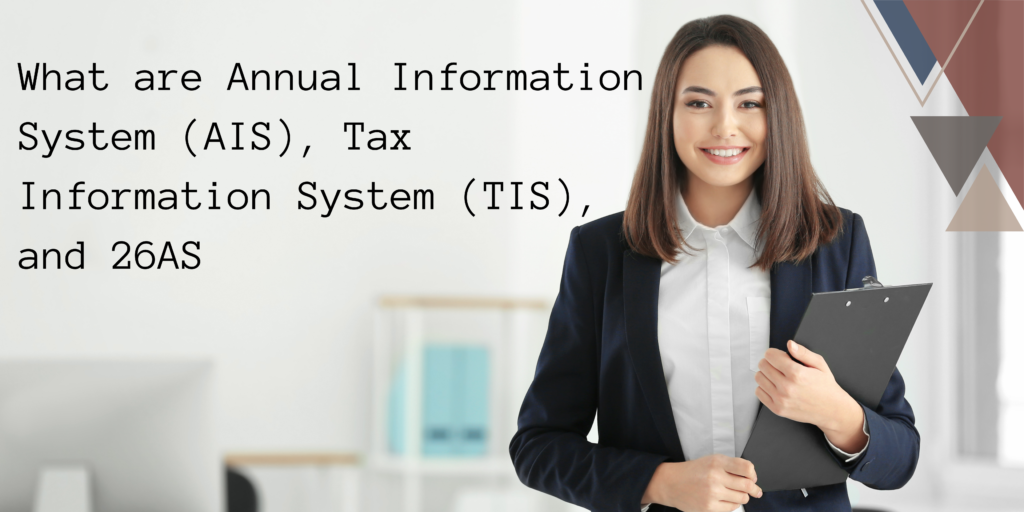What are Annual Information System (AIS), Tax Information System (TIS), and 26AS – How Income Tax Department keep an eye on you?

The task of submitting income taxes can be somewhat intimidating for numerous individuals. Understanding numerous income tax forms and their relevance is crucial to filing a correct and compliant return and avoiding any potential lawsuits (Income Tax Litigation). The three primary parts that govern the procedure are the Taxpayer Information Summary (TIS), the Annual Information System (AIS), and Form 26AS. In the sections that follow, they will be thoroughly discussed along with how they contribute to the proper preparation and filing of income tax returns. Continue reading for a thorough explanation of TIS and AIS.
The Annual Information Statement (AIS): What is it?
The Annual Information System (AIS), a powerful tool for obtaining information on a taxpayer’s financial transactions, was launched by the Income Tax Department in India. During a fiscal year, an individual taxpayer receives money from a number of sources, such as earnings, rent, interest income, and so on. The AIS is in charge of gathering data regarding these various revenue streams, taxpayer-paid taxes, taxes deducted at source (TDS), and other relevant tax-related information. An essential conduit between taxpayers and the Income Tax Department is provided by AIS.
Form 26AS provides taxpayers with a comprehensive view of tax credits, tax liabilities, and other relevant tax-related information.
Consider the taxpayer Mr. X as an illustration. Mr. X receives revenue from a number of sources, including interest, his rental income, and his wages. When Mr. X receives these sources of income, the relevant parties—such as the bank, tenant, or employer—withhold the required amount of tax from him at the source. In addition, Mr. X pays advance taxes and self-assessment taxes. All of this crucial tax-related information is gathered and arranged by the AIS into a comprehensive document known as Form 26AS.
AIS’s Function in Income Tax Returns
The Annual Information System (AIS) and Form 26AS are crucial parts of the process for completing an income tax return. By utilising Form 26AS to access the AIS, taxpayers can obtain a comprehensive and lucid picture of their tax credits and liabilities. By comparing the information in their own records with Form 26AS, they can use this to find any discrepancies or missing data. Taxpayers can prevent any issues with the tax authorities by correcting any errors or omissions prior to completing the ITRs, ensuring accurate reporting of income and taxes.The Taxpayer Information Summary (TIS) is a statement that aggregates all of the tax information that is on file with the Income Tax Department for a certain taxpayer. It serves as an overview of the taxpayer’s tax-related actions and provides significant insights into their tax compliance.
The TIS statement contains details on the taxpayer’s tax return submission history, taxes paid, refunds received, and any outstanding tax obligations. This useful tool helps taxpayers review and compare their personal tax records with the information maintained by the Income Tax Department.
TIS’s function in filing income taxes
The Taxpayer Information Summary is a crucial component of the income tax return (ITR) filing process (TIS). By reviewing their TIS statement, taxpayers can verify the accuracy of their tax-related data and ensure that it corresponds with the information maintained by the Income Tax Department. Additionally, it helps people reconcile their personal tax records with the information maintained by the Income Tax Department. It provides an opportunity to identify any missing or erroneous information that needs to be corrected prior to filing the ITR.
By being proactive, taxpayers can shield themselves from penalties and inquiries. The TIS statement is a reliable source of information for tax assessments and audits as well. It provides a concise overview of the taxpayer’s tax compliance and serves as evidence of their tax-related activities. By regularly adhering to the TIS declaration, taxpayers are able to maintain accountability and transparency in their tax affairs.
AIS and TIS access
Taxpayers must have access to the Annual Information System (AIS) and Taxpayer Information Summary (TIS) in order to ensure accuracy in their tax filings and to be informed about their tax responsibilities. Taxpayers can easily view their AIS and TIS statements online with the help of the Income Tax Department.
Through the Income Tax Department’s e-filing system, taxpayers can view their AIS and TIS statements online. By signing into their e-filing accounts, they can view and download their AIS and TIS statements whenever it’s convenient for them. They can also regularly check their AIS and TIS statements to stay on top of their tax-related operations. It provides an opportunity to verify the accuracy of the data and reconcile it with their own records.
Why Do Taxpayers Need to Know About AIS and TIS?
The Annual Information System (AIS) and Taxpayer Information Summary (TIS) are crucial instruments in the tax compliance process for both individuals and organisations. Let’s clarify how:
- Taxpayers can access the AIS and get a consolidated view of their tax credits and liabilities by completing Form 26AS. They are able to monitor the money coming in from various sources, the taxes being withheld at the source, and the timely payment of taxes thanks to this. Taxpayers may optimize their tax savings, minimize penalties for non-compliance, and manage their taxes more skillfully by keeping an eye on a variety of tax-related data.
- By regularly reviewing their TIS statements, taxpayers may guarantee the accuracy of their tax information. By comparing the data in the TIS statement with their own records, they can identify any discrepancies or missing information that would need to be fixed. By using the TIS statement to reconcile their tax records, taxpayers may make sure that all relevant income, taxes paid, and refunds received are properly reported.
- The AIS and TIS statements offer accountability and transparency in the tax system. The AIS and TIS declarations are helpful tools for tax assessments and audits. They provide tax authorities with an extensive record of the taxpayer’s financial dealings and tax liabilities, allowing them to assess the accuracy and consistency of the information on the income tax forms.
The Distinctions Between TIS and AIS
Although they both offer vital tax-related data, AIS and TIS serve distinct purposes. The following are the distinctions you should be aware of:
Information Type: AIS provides information on every financial move you make throughout the fiscal year, including acquisitions and sales of real estate, investments, and more. TIS, however, has details regarding your income tax returns, demand, and refund status.
Goal: By assisting customers in cross-referencing their income and assets with the data that is on file with the tax department, AIS aims to assist taxpayers in ensuring the accurate submission of income tax returns. TIS is designed to give taxpayers an overview of their tax payments, completed returns, and refund status.
Conclusion
Understanding the Annual Information Statement (AIS) and the Taxpayer Information Statement (TIS) is crucial for effective tax planning and compliance. These records are available through the income tax site and provide taxpayers with a consolidated view of their financial operations and tax status. However, figuring out these components can be challenging, so getting advice from personal finance advisory firms or tax professionals can be beneficial. Seek out experts who can assist you with comprehending these statements, ensuring the accuracy of your income tax return, and providing guidance on efficient tax planning.
For More Blogs :- https://akyvandco.in/blog/
